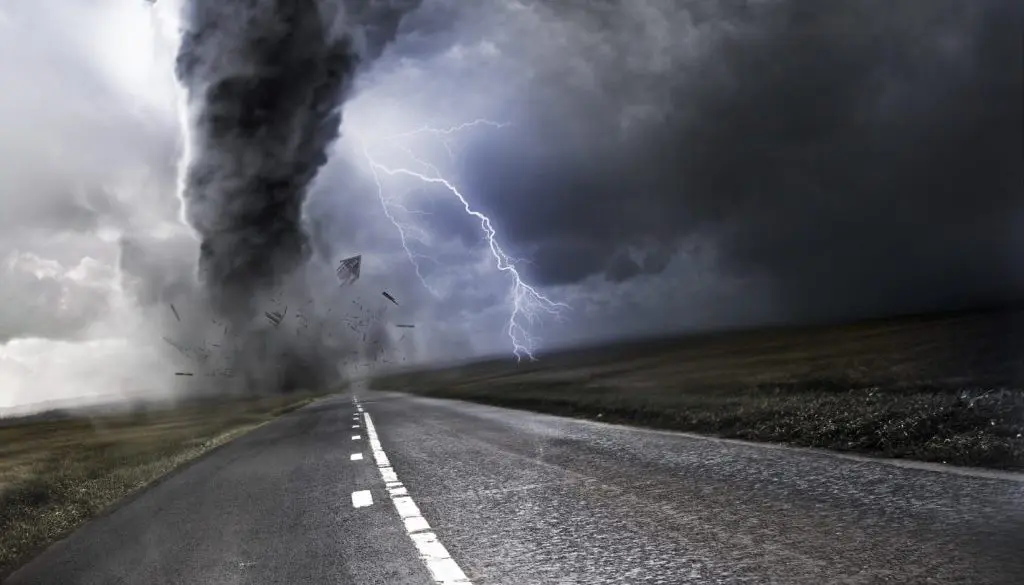Advanced Planning for Tornadoes Prepares Communities for Last-Minute Danger
Tornadoes occur during violent thunderstorms and sometimes accompany hurricanes. Their high wind speeds and ability to strike instantly while demolishing communities within seconds make them some of the most dangerous natural disasters.
Though tornadoes can occur anywhere, Tornado Alley sees the highest number of tornadoes every year. This region encompasses Nebraska, Kansas, Oklahoma, Iowa, Missouri, and parts of Texas, Colorado, and South Dakota.
The U.S. average of tornadoes has reached 1,200 per year, which is the highest average globally, and the results are disastrous. Tornadoes cause roughly 80 deaths and over 1,500 injuries, along with $11.23 billion in damages annually.
Most tornadoes happen in the late afternoon to early night and last about ten minutes, but there have been some reports of tornadoes lasting over an hour.
Because there is an average lead time of 13 minutes to seek shelter, timing is everything when protecting communities from the devastation that can lie in a tornado’s wake.
How to Prepare for the Worst
2020 was stormy — there were a record-breaking 22 severe weather and natural disaster events, 13 of which were severe storms. One of the costliest storms of the year was the derecho, a violent windstorm that accompanied severe thunderstorms that produced wind speeds of over 70 mph for hours in a 770-mile radius. Tornado warnings were in effect in Chicago, an area that does not typically see tornadoes.
These types of storms can cause unpredictable damage, so being ready at a moment’s notice is imperative for the safety of all community members.
Emergency responders, 9-1-1 teams, local government officials, and members of high-risk communities need a system that allows strong communication and advanced preparation. This allows for better strategy, response, and execution when adverse weather conditions turn into tornadoes.
Such a system can help emergency responders act quickly and efficiently, while giving local government officials the resources to provide updates and inform residents, schools, hospitals, and businesses of the best plan of action.
Collaboration can save lives
Weather alerts during favorable tornado conditions cannot always be issued in advance. Severe thunderstorms may not always produce tornadoes, even with high wind speeds. Though the National Weather Service has two levels of tornado alerts — tornado warning and tornado watch — whether or not these storms will turn into tornadoes cannot be predicted.
A solid action plan made before adverse weather conditions strike is the key to saving lives during a tornado. Since they happen fast, key stakeholders and emergency personnel must also know how to respond in the aftermath.
Tornadoes can topple buildings, pick up and drop debris, and swipe cars into their wind funnels, creating extremely hazardous conditions. Many people become trapped under debris, making it vital that first responders have an increased level of situational awareness.
Key stakeholders and emergency response teams across multiple industries must know how to delegate tasks and reach out to at-risk community members before such danger occurs.
How Rave Mobile Safety Can Help
K-12 Schools
Prepare schools with tornado drills and alerts that keep parents, faculty, and students informed of potentially hazardous conditions.
Healthcare
Hospitals must decide between emergency evacuations or shelter-in-place. This is the most important safety decision emergency managers make during tornadoes. Advanced preparation ensures they make the right call with little warning.
State or local community
Inform residents of how to shelter-in-place, direction and speed of the storm, and action steps needed following tornadoes.
Corporate
Inform employees of possible and present dangers and implement strategies to keep them safe at the workplace.
Higher Education
University officials can inform their campuses of potential tornado threats with clear, accurate information and safety drills to minimize fear and increase preparedness.
Safety in the aftermath of tornadoes
High winds are to blame for most of the damage caused by tornadoes. Averages of 25-40 mph are enough to destroy bridges, flip trains, send vehicles airborne, suck water from rivers and creeks, and completely demolish homes and businesses.
After a tornado, mobility may be limited as transportation is no longer safe. Resources such as electricity and running water can take days, even weeks, to turn back on. While we may not prevent these devastating natural disasters from occurring, we can ensure that we are prepared to handle them when they arrive.
A tactical incident collaboration tool allows leaders to activate scenario-specific tasks to personnel across multiple departments. This tool can integrate with mass notification software, providing directions, clear responsibilities, and coordination between all emergency personnel.
Find out how your community can prepare for tornadoes with through the Rave Platform, do not hesitate to request a demo, or contact the Rave team.





